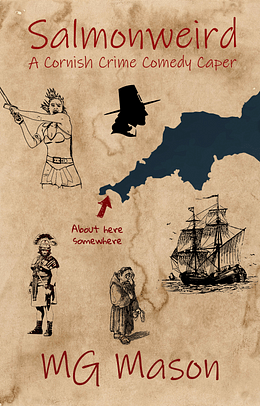You are here
Home › Books › M.G. Mason's novel 'Salmonweird' Explores The Livelier Side Of Life After Death ›M.G. Mason's novel 'Salmonweird' Explores The Livelier Side Of Life After Death
FTC Statement: Reviewers are frequently provided by the publisher/production company with a copy of the material being reviewed.The opinions published are solely those of the respective reviewers and may not reflect the opinions of CriticalBlast.com or its management.
As an Amazon Associate, we earn from qualifying purchases. (This is a legal requirement, as apparently some sites advertise for Amazon for free. Yes, that's sarcasm.)

Since time immemorial humans from every civilization and have been fascinated with what lies past this mortal coil. It’s the Eternal Mystery: once we exhale that final breath, is there only the dark embrace of oblivion, or do we, as some assert, continue to exist in some spectral state? While the more practical among us may scoff at the notion of post-mortem survival, according to a 2021 survey conducted by the analytics company YouGov, two out of every five Americans—roughly 41%—believe in ghosts. The results get spookier from there: a similar 2009 Pew Research Center study found eighteen percent report encountering a spirit, whether by seeing, hearing or being physically touched.
In the 1840’s, Kate and Margaret Fox, sisters from Hydesville, New York, reportedly established contact with an entity claiming to be the spirit of a murdered peddler buried beneath their house. As the first celebrity mediums, the sisters became famous for public séances, and their believers later established Spiritualism, a movement that focused on communication with the afterlife through a variety of means, including automatic writing, table-tipping, and ectoplasmic manifestation. Despite much of Spiritualism’s credibility becoming tarnished by hucksters and frauds eager to exploit those desperate for some glimpse into the hereafter, the permanent parade of paranormal TV programs prove the subject exerts as much sway today as in Victorian times.
One author plumbing the spectral to entertaining effect is Swindon, UK-born M.G. Mason, whose novel Salmonweird deftly explores the livelier side of life after death. Originally published in 2019 and subtitled A Cornish Crime Comedy Caper, the narrative opens with a brief introductory segment, ‘Salmonweir Tourist Board: A Guide to the Non-Living Residents’, in which readers are acquainted with the seaside village and its eclectic denizens. Situated on the sparsely-populated southwestern coast of England, Salmonweir has a population of five-hundred persons, only one of which, retired Cambridge Detective Inspector Karl Blackman, is alive. The others are ghosts who have inexplicably and unexpectedly returned from the Great Beyond to the shock and fascination of the British public. With the remaining corporeal residents—Karl’s wife Valerie among them—having abandoned the town, Karl now spends his days as the sole flesh-and-blood inhabitant coming to terms with his new neighbors.
Dubbed ‘Salmonweird’ by hungry tabloids, the village’s ghosts are a thoroughly motley cast: there’s Hook Hand Harry, a rummy pirate whose crew lives aboard a Flying Dutchman-style ship anchored in the harbor; the Black Death-era Catholic monk Jowan and his feuding ideological opposite, Cromwellian Protestant reformer Eli. There’s Kensa, the Iron Age warrior queen and feisty pub matron Morwenna; mournful World War II widow Dora Wilson, and headstrong nineteenth-century teenager Ebrel Penrose.
But what happens in a village of ghosts when one of their own comes up missing? And does the ominous evidence left at the potential kidnapping scene indicate that something far more sinister is afoot in Salmonweir? Can the dead die a second time?
While echoing the work of Rudyard Kipling and Neil Gaiman (whose character Bod Owens from the similarly-themed 2008 human-among-ghosts exercise The Graveyard Book would find familiar bliss in Salmonweir), at its core Salmonweird is a procedural rife with eccentric English flair. Karl’s good-natured, conversational first-person narration draws the audience into the unusual situation with considerable ease. Though the subject matter—death, murder, betrayal, suicide—is sometimes heavy, Mason keeps the overall tone light by emphasizing offbeat characterization and wringing wry humor from the villagers’ fish-out-of-water escapades. Having been resurrected from different centuries, many of Salmonweir’s phantoms experience difficulty adjusting to the modern world, while others—Roman Centurian Cato, the aforementioned Puritan zealot Eli and in particular Ebrel (who continually pesters her father for an iPhone)—embrace the new age they’ve awakened in.
Mason likewise maintains an appreciated fairness with the novel’s sleuthing: this isn’t some ghost story posturing as a half-hearted mystery, but a well though-out whodunit, filled with twists, turns, red herrings and vital clues. Another rewarding aspect of Salmonweird is the subtle world-building; though most of the plot occurs within the self-contained boundaries of the village itself, on those occasions when Karl leaves town we become privy to the mixture of curiosity and media-inspired trepidation with which the public-at-large considers his humble home.
In an ideal universe the BBC would be readying a live-action Salmonweird television series, but wishful fans will instead have to content themselves with the happy knowledge that two additional books (the yuletide-set A Salmonweird Sleighing and a short story collection Spooky Salmonweird: Tales From The Village) are currently available, with a third (Studio Salmonweird) set for release September 4th. Those who sign up for Mason’s email newsletter will also receive additional fictional asides to their inbox (like ‘A Salmonweird Lockdown’, set during the opening stages of the Covid-19 pandemic), that go some way towards scratching that phantom itch.
Quirky, inventive and enjoyable from first line to last, Salmonweird: A Cornish Crime Comedy Caper earns a near-perfect 4.5 (out of 5) on my Fang Scale. After all, how can one not find joy in a novel whose copyright page notes that ‘Any resemblance to real persons, living, dead or presently identifying outside of the binary living/dead state of existence, is purely coincidental’? Bring on Book Two!


